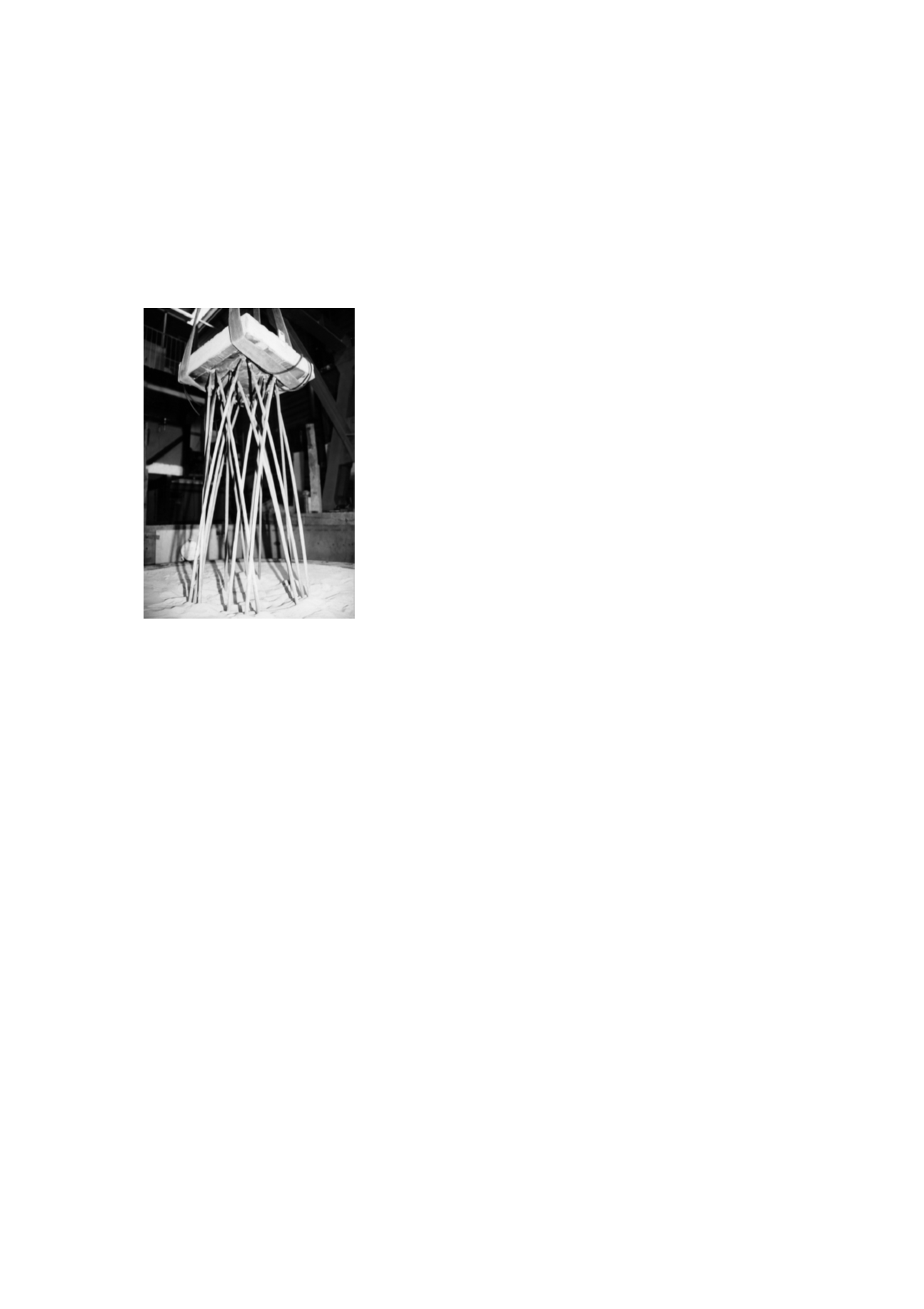

Proceedings of the 18
th
International Conference on Soil Mechanics and Geotechnical Engineering, Paris 2013, volume 6, 2016
which was also found in the numerical studies conducted at
CERMES, could yield a greater capacity for the network relative
to that of the equivalent group.
Tank-based tests performed at the 3S Laboratory in Grenoble
used networks with a significantly higher number of micropiles
(N = 18) and a better level of interlocking (
< 0° and
> 180°,
with micropile intersections), as shown in Figure 9. In the case
of a near cylindrical network (defined by
= 20° and
= -
30°/210°), a positive effect is observed on load-bearing capacity
relative to the equivalent group, beginning with the smallest
displacements. In all cases, a strain hardening phenomenon is
identified, thus confirming the soil passive pressure phenomenon
on long and flexible inclusions.
Fig. 9: An 18-micropile network at the 3S Laboratory in Grenoble
5.5
Comments on transversally-loaded networks
The horizontal loading tests only involved simple networks:
double easels (A-shaped) at the St Rémy-lès-Chevreuse site, and
single easels (A-shaped) at sites in Alabama (U.S.) and St
Maurice (France). These results have confirmed that micropile
inclination exhibits a highly beneficial impact on the resistance
to transverse forces. These cases are merely static loadings, yet
results are similar for dynamic or seismic loadings.
As for the double easels at the St Rémy-lès-Chevreuse site,
horizontal resistance is 2 to 3 times greater than that of the group
with a relative S/B spacing = 2. The numerical studies carried
out at CERMES have confirmed this finding as well.
5.6
Conclusions and recommendations
Research conducted within the scope of the
FOREVER
NP has
given rise to over 70 reports and articles. It has also led to the
publication of a 347-page book entitled "
Synthesis of the
results and recommendations of the French National Project
on micropiles
" by
Presses des Ponts et Chaussées
. An English
language translation was published by the American ADSC
Association on behalf of the Federal Highway Administration.
Moreover, a compilation of this book's scientific results has
served as the basis for several additional projects at foreign
universities. In another outcome, the collaborative research
completed as part of
FOREVER
has fostered creation of the
International Society for Micropiles (ISM), which associates
practitioners from North America, Europe and Japan.
5.6.1 Micropile groups
These experimental results have revealed a positive group effect
(i.e. C
e
> 1) for groups that include a large number of flexible
piles, with this effect being primarily due to soil confinement
between micropiles. This point has been confirmed by the high
skin friction values whenever measurements were feasible.
The group effect reaches a maximum at a relative S/B
spacing between micropiles = 2.5 to 4. For higher values, the
level of confinement is reduced and the load-bearing capacity of
the group approaches the sum of all load-bearing capacities of
the various isolated micropiles (C
e
= 1). It is obvious that
confinement can be improved by means of an appropriate
micropile placement method (e.g. driving or jacking into loose
sands).
As regards underpinning of foundation, it has been
confirmed, as shown in research and studies on the
Pont de
Pierre
in Bordeaux, that micropiles offer an efficient and well
adapted solution for stabilizing the foundation movements of old
structures.
5.6.2 Resistance of micropile groups to horizontal forces
The experiments performed on groups of horizontally-loaded
micropiles indicate that these group effects are comparable to
those of regular piles with conventional diameter dimensions:
- the total resistance of a micropile group is less than the sum
of each individual resistance of all micropiles due to the shadow
effect of piles placed in front of the micropiles located in back,
yet this negative effect may be neglected once the spacing
reaches 6 to 7 diameters;
- whenever micropiles are placed in a row perpendicular to
the loading direction, the group resistance is weakened by
mechanical interactions within the soil. This decrease however
remains modest and may be neglected once spacing has
exceeded 3 diameters;
- micropiles installed by means of soil displacement show
greater stiffness in a horizontal loading pattern than micropiles
placed using techniques that do not displace the soil.
5.6.3 Numerical methods for estimating the displacements of a
micropile group
Research conducted within the scope of
FOREVER
has led to
developing the GOUPEG Program, which makes use of the
(t-z)
and
(p-y)
transfer functions, as well as linear elasticity for the
interactions between micropiles. This program is naturally also
valid for piles.
In order to calculate the displacement of micropile groups, a
distinction needs to be drawn between two types of effects that
differ considerably in their nature:
- effects due to the implementation technique, which modifies
soil properties both in the vicinity and at the soil/micropile
interface (effects that can only be estimated since a calculation
proves impossible);
Volume 6 - Page 82









